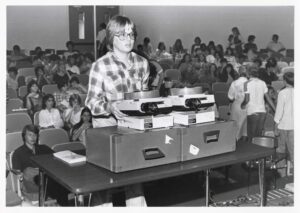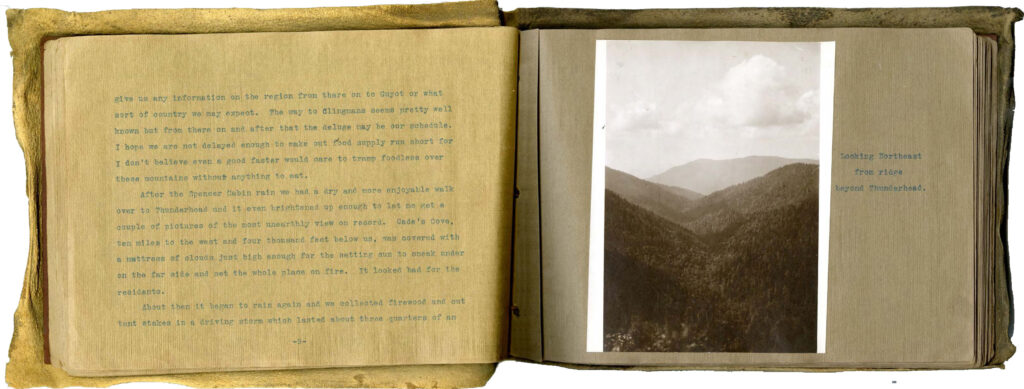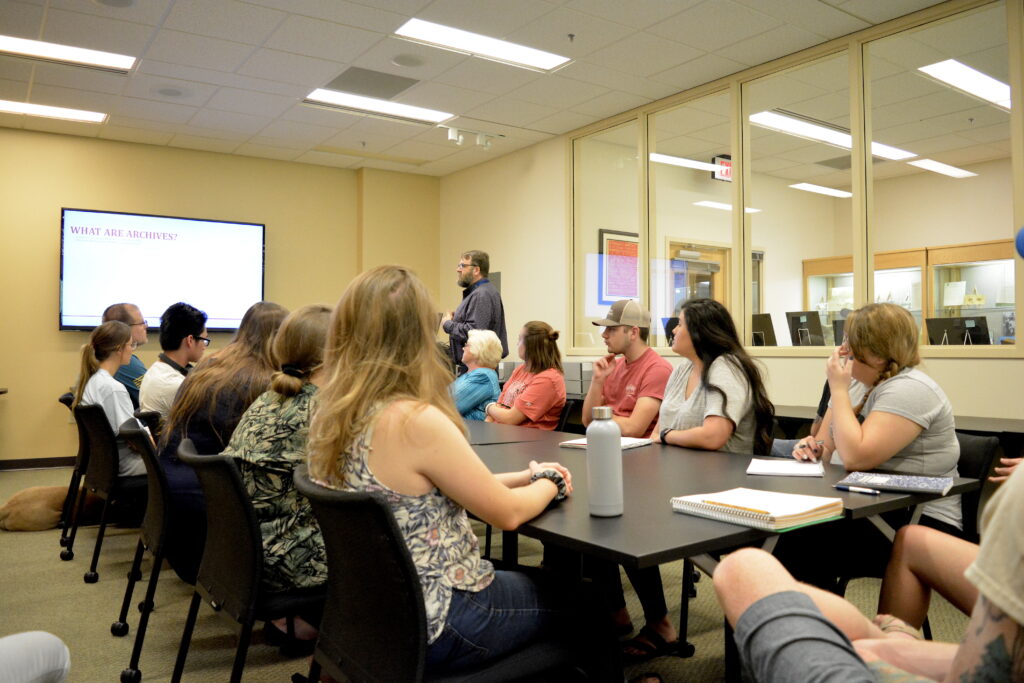This article appeared in the Volume 2, Issue 1 Spring/Summer 2020 issue of the Appalachian Curator. Click here to view a PDF of the full issue.
The Archives of Appalachia at East Tennessee State University
By Jeremy A. Smith
The Archives of Appalachia at East Tennessee State University preserves the written words, images, and sounds that document life in southern Appalachia. Since its beginning in 1978, the Archives has sought to support original research, educational engagement, public outreach, and artistic creativity. Over the past forty-two years, the Archives has grown into one of the leading repositories in the world for preserving and providing access to southern Appalachia’s history and culture. Today the Archives’ collections include almost two miles of rare manuscripts, over 90,000 audio and moving image recordings, 250,000 photographs, 15,000 books, and over twenty terabytes of digital materials. More than 2,000 visitors from around the globe utilize the Archives’ collections each year for in-depth research projects, and over 50,000 more interact annually through our website, digital collections portal, and social media platforms.
Foundational Years
The foundation of the Archives’ collection came from two ETSU Research Advisory Council projects. The first began in 1958 with the deposit of the Washington County Court Records at what was then East Tennessee State College. The College Library designated a space for the records, and this

eventually became known informally as the library archives. (This material was transferred in 2011 to its permanent home at the Washington County Archives in Jonesborough, TN.) The second project, the Oral History Archives (1968-1972), arose from the work of professors Thomas G. Burton and Ambrose N. Manning. Their efforts to document Appalachian folklore, music, and customs included groundbreaking ethnographic work in the region. The project, known today as the Thomas G. Burton-Ambrose N. Manning Collection, became one of the inaugural collections of the Archives of Appalachia when it opened in 1978.
The Archives’ first director, Dr. Richard Kesner, served the institution from 1978-1981, laying a strong foundation of intentional collections growth and innovative outreach efforts. During these early years, the Archives sought manuscript, print, photographic, and media collections that documented all aspects of life in southern Appalachia, laying the groundwork for a collection that now extends from the 18th through the 21st centuries. Subject strengths include folk traditions, industrial and transportation history, social justice, religious practices, music and the arts, and the history of ETSU.

An Emphasis on Outreach
From 1979-1982, two grants from the National Endowment for the Humanities (NEH), allowed the Archives to produce a series of nine multi-media outreach programs, along with study guides. The programs drew upon materials in the Archives’ collections and were presented hundreds of times to thousands of people throughout southern Appalachia.
The Archives’ outreach work continued under its second director, Dr. Ellen Garrison, who came to the Archives in 1982. Garrison directed a second significant outreach program, from 1982-1983, known as “Tennessee’s Mountain Heritage.” The program resulted in a series of radio shows based on materials from the Archives’ holdings that provided an overview of the social history and folklore of southern Appalachia.
Collections Growth
The Archives benefited from increased institutional support in 1984 when ETSU received a grant from the Tennessee Higher Education Commission (THEC) to establish the Center of Excellence for Appalachian Studies and Services (CASS). The Archives became one of three units of CASS, along with the Reece Museum and the Institute of Appalachian Affairs. Through this association, the Archives received support for additional staff and equipment, as well as funding for a range of preservation and outreach projects.
In 1988, Norma (Myers) Riddle became the Archives’ third director. Under Riddle’s leadership, the Archives’ collections continued their robust growth, adding hundreds of new collections on a range of historical and cultural topics related to southern Appalachia. Significant additions included the papers of the long-serving member of the U.S. House of Representatives James H. Quillen; the Coal Employment Project Papers, which document the struggle for workers’ rights for female coal miners; the records of the East Tennessee & Western North Carolina Railroad; and unique recorded sound collections including the Mary Elizabeth Barnicle and Tillman Cadle Collection of field recordings from the 1930s through the 1950s.

Increased media collections created unique demands for preservation and access, and during Riddle’s tenure the Archives applied for, and received, more than a dozen grants to preserve rare audio and moving image holdings. A major grant from the NEH in 2003 funded a large preservation project and served as the basis for the creation of the Archives’ media digitization lab. Over time, the lab has developed the capacity for digitizing over a dozen analog audio and moving image formats.

In the 1990s, work promoting digital access to collections continued. In 1996, the Archives entered the digital era with the launching of its first homepage, and in 1997 it was selected to participate in the “Monticello Electronic Library” pilot project, which was an attempt to make collection descriptions available online for twenty-two repositories in the southeast. By 2000, the Archives had succeeded in making all of its finding aids available online.
Outreach remained a focus for the Archives throughout the 1990s and beyond. From 1994-1995, the Archives worked with Panther Press to publish a two-volume series of hiking diaries from the D.R. Beeson, Sr. Papers. The series, edited by Riddle and Archivist Ned Irwin, was titled In the Spirit of Adventure and featured diary transcripts and photographs of hikes that Beeson and C. Hodge Mathes made of the Great Smoky Mountains (1914) and Mt. Mitchell (1915). The Archives also produced a number of successful public programs during this period, most notably a film series in 2004-2005 that featured rare films from the Archives’ holdings, which reached over 1,500 people.

A New Home for the Archives
On February 1, 1999 the Archives moved from its original location in what is now known as Nicks Hall to its present location on the fourth floor of the Charles C. Sherrod Library. With the move, the Archives acquired much-needed storage space for its rapidly growing collections. It also received increased space for its public reading room and dedicated facilities for its state-of-the-art media preservation lab. The relocation allowed the Archives to continue expanding its manuscript holdings and to extend both its educational and public services.

In July 2010, ETSU selected Amy Collins as the Archives’ fourth director. Collections growth continued, and Collins placed an emphasis on formalizing a range of policies that clarified workflows and standardized collection development and research access. The Archives also officially initiated an education and outreach program in 2012, with the hiring of its first Education and Outreach Archivist. As a result of this program, additional resources were devoted to supporting student research and scholarship, including the creation of a new electronic classroom and student learning center in 2014.

At the same time, Archives staff curated a major new permanent exhibit in the reading room, highlighting the broad range of scholarly and creative projects that the Archives’ collections have supported over time. Work digitizing collections also continued, as the Archives laid the groundwork for a partnership with the Sherrod Library’s Digital Commons to provide online access to official ETSU publications.
Emphasis on Digital Access
Upon Collins’ retirement in 2018, ETSU selected Dr. Jeremy A. Smith as the Archives’ fifth director. Since that time the Archives has continued to emphasize digital access to collections, establishing its first digital collections portal in the summer of 2019, enhancing its infrastructure for digitizing oversize print items, and providing file-based streaming access to a portion of its media collections.

The Archives has also enjoyed continued success in receiving grants, including two in 2019 from the Gladys Krieble Delmas Foundation and the National Recording Preservation Foundation that have allowed the Archives to enhance access to its recorded sound collections. In 2019 the Archives also awarded its first research grants through the newly-established Margaret Anne Byrd Huffman Archives of Appalachia Endowment Grant.
The Archives’ Future
As the Archives’ collections and services continue to expand to meet its patrons’ evolving needs, its foundation remains an ongoing dedication to serving the people of southern Appalachia. The Archives has a proud history as a center for historical and cultural inquiry that engages students, faculty, and the broader Appalachian community in the work of knowledge production. In the future, the Archives will continue to preserve the stories of the people and the institutions that have defined what this region has been, while supporting those researchers who are imagining, through scholarly and creative projects, what this region might become.
Jeremy A. Smith is Director of the Archives of Appalachia at East Tennessee State University